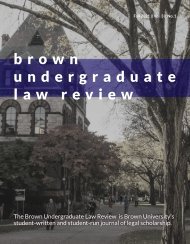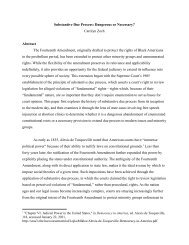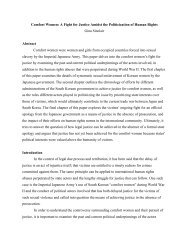Brown Undergraduate Law Review -- Vol. 2, No. 1 (Fall 2020)
We are proud to present the Brown Undergraduate Law Review's Fall 2020 issue. We hope you will all find our authors' works fascinating and thought-provoking.
We are proud to present the Brown Undergraduate Law Review's Fall 2020 issue. We hope you will all find our authors' works fascinating and thought-provoking.
Create successful ePaper yourself
Turn your PDF publications into a flip-book with our unique Google optimized e-Paper software.
Land Grabs and the Reach of the Law: Reforming Large-Scale Land Acquisition in Sub-Saharan Africa
deals occurring in Sudan. 24 The impact of inadequate staple crops. This increased demand for freshwater can
compensation has gendered dimensions as well; in Ghana, lead to the formation of hotspots and water scarcity for
women farmers are given little or no compensation in local communities. One notable example is Central Africa,
exchange for confiscated land, and are often excluded from where extensive irrigation projects have caused Lake Chad
negotiations with land owners. 25
to shrink by 95 percent since the 1960s. 29
The development of social services and public goods can
be viewed as an alternative form of compensation. These
projects can range from road-building, to constructing or
improving processing facilities, to donating hospitals or
schools. Such promises sometimes materialize, such as in
the DRC, where investors of a rubber plant built a 230-bed
infirmary, 26 but are just as often forgotten, with particular
frequency in Ethiopian land deals. 27
Environmental Impacts
The environmental effects of LSLAs are largely negative,
straining water resources and damaging investment sites
and surrounding ecosystems. Aggressive agricultural
techniques used on leased land such as over-fertilization
and land-clearing can result in marked increases in air
pollution and soil erosion. In addition, farming practices
can disrupt ?indigenous forests that serve as migratory
corridors for endangered species.? 28 Agricultural
production can be sustained via blue water (irrigation) and
green water (precipitation and evapotranspiration). A large
share of LSLA crops, such as jatropha and sugarcane,
require large amounts of blue water, relative to traditional
Food Security
In theory, LSLAs could alleviate food insecurity for
investor and host countries; if all current land deals
manage to close their agricultural yield gaps (the
difference between potential and actual crop production),
the continent of Africa would be able to feed
approximately 50 million additional people relative to the
status quo. Such findings, however, presume lower levels
of biofuel production and nonedible forestry relative to
food production, and that investors will behave in a perfect
and uniform manner. 30 In addition, adverse climate change
impacts (in relation to aforementioned irrigation schemes,
deforestation, etc.) may come at the cost of widespread
cultivation, hindering gains in global food security. 31
Notwithstanding the future implications for improved
global food security, the benefits of foodstuffs harvested
from SSA lands have failed to attenuate local food
insecurities in the present. Despite holding over 60 percent
of the world?s uncultivated arable land, Africa continues to
be a net food importer, and suffers from volatile food
markets. 32 Furthermore, sources of local food insecurity
24. Ibid., 177?179.
25. Benjamin Arthur and Kwame Mensah, ?Assessing Community Consent in Large Scale Land Investments in Ghana,? Civic Response, (2017), 2,
22.
26. Hufe and Heuermann, 177?179.
27. Tsegaye Moreda, ?Large-Scale Land Acquisitions, State Authority and Indigenous Local Communities: Insights from Ethiopia,? Third World
Quarterly, vol. 38, no. 3 (March 2017), 698?716.
28. Hufe and Heuermann, 180.
29. Emma Li Johansson, et al., ?Green and Blue Water Demand from Large-Scale Land Acquisitions in Africa,? Proceedings of the National
Academy of Sciences of the United States of America, vol. 113, no. 41 (2016).
30. Maria Cristina Rulli and Paolo D?Odorico. ?Food Appropriation through Large Scale Land Acquisitions,? Environmental Research Letters, vol.
9, no. 6 (June 26, 2014).
31. Liette Connolly-Boutin and Barry Smit., ?Climate Change, Food Security, and Livelihoods in Sub-Saharan Africa,? Regional Environmental
Change, vol. 16, no. 2 (February 13, 2015).
32. Wim Plaizier, ?How Africa Can Feed the World,? World Economic Forum, (January 22, 2016).
Brown Undergraduate Law Review
24










